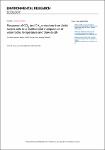Response of CO<sub>2</sub> and CH<sub>4</sub> emissions from Arctic tundra soils to a multifactorial manipulation of water table, temperature and thaw depth
| dc.contributor.author | Best, K | |
| dc.contributor.author | Zona, D | |
| dc.contributor.author | Briant, E | |
| dc.contributor.author | Lai, C-T | |
| dc.contributor.author | Lipson, DA | |
| dc.contributor.author | McEwing, KR | |
| dc.contributor.author | Davidson, SJ | |
| dc.contributor.author | Oechel, WC | |
| dc.date.accessioned | 2024-04-24T12:18:41Z | |
| dc.date.available | 2024-04-24T12:18:41Z | |
| dc.date.issued | 2023-12-01 | |
| dc.identifier.issn | 2752-664X | |
| dc.identifier.issn | 2752-664X | |
| dc.identifier.uri | https://pearl.plymouth.ac.uk/handle/10026.1/22316 | |
| dc.description.abstract |
Significant uncertainties persist concerning how Arctic soil tundra carbon emission responds to environmental changes. In this study, 24 cores were sampled from drier (high centre polygons and rims) and wetter (low centre polygons and troughs) permafrost tundra ecosystems. We examined how soil CO2 and CH4 fluxes responded to laboratory-based manipulations of soil temperature (and associated thaw depth) and water table depth, representing current and projected conditions in the Arctic. Similar soil CO2 respiration rates occurred in both the drier and the wetter sites, suggesting that a significant proportion of soil CO2 emission occurs via anaerobic respiration under water-saturated conditions in these Arctic tundra ecosystems. In the absence of vegetation, soil CO2 respiration rates decreased sharply within the first 7 weeks of the experiment, while CH4 emissions remained stable for the entire 26 weeks of the experiment. These patterns suggest that soil CO2 emission is more related to plant input than CH4 production and emission. The stable and substantial CH4 emission observed over the entire course of the experiment suggests that temperature limitations, rather than labile carbon limitations, play a predominant role in CH4 production in deeper soil layers. This is likely due to the presence of a substantial source of labile carbon in these carbon-rich soils. The small soil temperature difference (a median difference of 1 ◦C) and a more substantial thaw depth difference (a median difference of 6 cm) between the high and low temperature treatments resulted in a non-significant difference between soil CO2 and CH4 emissions. Although hydrology continued to be the primary factor influencing CH4 emissions, these emissions remained low in the drier ecosystem, even with a water table at the surface. This result suggests the potential absence of a methanogenic microbial community in high-centre polygon and rim ecosystems. Overall, our results suggest that the temperature increases reported for these Arctic regions are not responsible for increases in carbon losses. Instead, it is the changes in hydrology that exert significant control over soil CO2 and CH4 emissions. | |
| dc.format.extent | 045003-045003 | |
| dc.publisher | IOP Publishing | |
| dc.subject | 30 Agricultural, Veterinary and Food Sciences | |
| dc.subject | 31 Biological Sciences | |
| dc.subject | 3103 Ecology | |
| dc.subject | 3007 Forestry Sciences | |
| dc.subject | 13 Climate Action | |
| dc.title | Response of CO<sub>2</sub> and CH<sub>4</sub> emissions from Arctic tundra soils to a multifactorial manipulation of water table, temperature and thaw depth | |
| dc.type | Journal Article | |
| plymouth.issue | 4 | |
| plymouth.volume | 2 | |
| plymouth.publication-status | Published | |
| plymouth.journal | Environmental Research: Ecology | |
| dc.identifier.doi | 10.1088/2752-664x/ad089d | |
| plymouth.organisational-group | |Plymouth | |
| plymouth.organisational-group | |Plymouth|Faculty of Science and Engineering | |
| plymouth.organisational-group | |Plymouth|Faculty of Science and Engineering|School of Geography, Earth and Environmental Sciences | |
| plymouth.organisational-group | |Plymouth|REF 2021 Researchers by UoA | |
| plymouth.organisational-group | |Plymouth|Users by role | |
| plymouth.organisational-group | |Plymouth|Users by role|Current Academic staff | |
| plymouth.organisational-group | |Plymouth|REF 2021 Researchers by UoA|UoA14 Geography and Environmental Studies | |
| plymouth.organisational-group | |Plymouth|REF 2029 Researchers by UoA | |
| plymouth.organisational-group | |Plymouth|REF 2029 Researchers by UoA|UoA14 Geography and Environmental Studies | |
| dc.date.updated | 2024-04-24T12:18:41Z | |
| dc.rights.embargodate | 2024-04-27 | |
| dc.identifier.eissn | 2752-664X | |
| rioxxterms.versionofrecord | 10.1088/2752-664x/ad089d |


